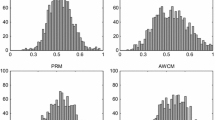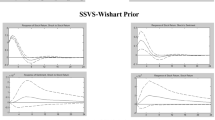Abstract
In recent years, a large number of research papers and monographs on the analysis of hedge fund returns have been published. Typically, the authors of these studies implicitly or explicitly treat monthly returns of hedge funds as independent and identically distributed observations. The Hedge Fund Index might be able to serve that role. But the returns of an individual hedge fund are not like that. They behave autoregressively depending on the time periods. This stochastic behavior should be modeled as a combined/regime switching stochastic process of two processes: i.i.d. process and autoregressive process. This paper first depicts the autoregressiveness of hedge fund returns. Then we introduce our statistical model for returns of an individual hedge fund and then, with our retrospective view, we perform several data analyses for individual hedge funds’ return data.
Similar content being viewed by others
References
Agawal V, Naik NY(2000) Performance evaluation of hedge funds with option-based and buy and hold strategies. Centre for Hedge Fund Research and Education Working Paper HF-003, London Business School
Anson M (2004) Strategic versus tactical asset allocation. J Portfolio Manage 30(2): 8–22
Asness C, Krail R, Liew J (2001) Do hedge funds hedge?. J Portfolio Manage 28(1): 6–19
Bollen NPB, Busse JA (2001) On the timing ability of mutual fund managers. J Financ 56: 1075–1094
Brown SJ, Goetzman WN (2003) Hedge funds with style. J Portfolio Manage 29(2): 101–112
Dopfel FE (2005) How hedge funds fit. J Portfolio Manage 31(4): 9–20
Fung W, Hsieh DA (1997) Empirical characteristics of dynamic trading strategies: the case of hedge funds. Rev Financ Stud 10: 275–302
Henriksson RD, Merton RC (1981) On market timing and investment performance II: statictical procedures for evaluating forecasting skills. J Bus 54: 513–533
Lhabitant FS (2004) Hedge funds: quantitative insights. Wiley, Chichester
Liew J, French C (2005) Quantitative topics in hedge fund investing. J Portfolio Manage 31(4): 21–32
Lo AW, MacKinlay AC (1999) A non-random walk down wall street. Princeton University Press, Princeton
Lo AW (2002) The statistics of sharpe ratios. Financ Anal J 57(6): 36–52
Scholes M, Williams J (1977) Estimating betas from nonsynchronous data. J Financ Econ 5: 309–327
Author information
Authors and Affiliations
Corresponding author
Rights and permissions
About this article
Cite this article
Miura, R., Aoki, Y. & Yokouchi, D. A note on statistical models for individual hedge fund returns. Math Meth Oper Res 69, 553–577 (2009). https://doi.org/10.1007/s00186-008-0251-8
Received:
Accepted:
Published:
Issue Date:
DOI: https://doi.org/10.1007/s00186-008-0251-8




